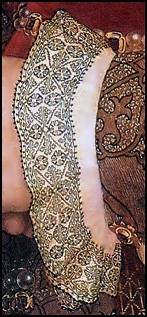This article needs additional citations for verification .(March 2023) |

Holbein stitch is a simple, reversible line embroidery stitch most commonly used in Blackwork embroidery and Assisi embroidery. The stitch is named after Hans Holbein the Younger (1497-1543), a 16th-century portrait painter best known for his paintings of Henry VIII and his children, almost all of whom are depicted wearing clothing decorated with blackwork embroidery.
Contents
Although superficially similar to Back Stitch the Holbein stitch produces a smoother line and a pattern that is identical on both sides of the fabric. It can be worked in straight lines, diagonally, or in a stepped fashion to make a zigzag line and is well suited to creating outlines or intricate filling patterns.
Holbein stitch is also known as double running stitch, line stitch, Spanish stitch, Chiara stitch and two-sided line stitch.







